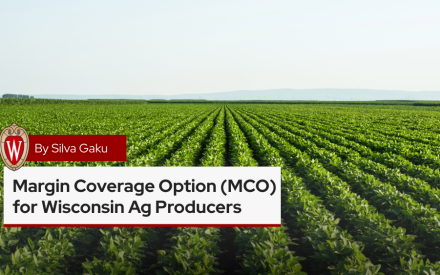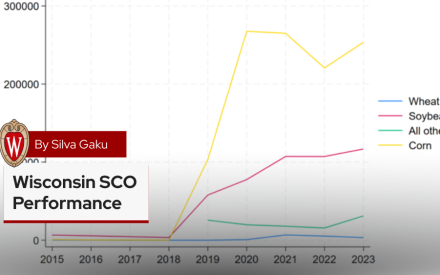Forage remains important in livestock farming; however, its production can be significantly impacted by factors, including drought, wildfire, flooding, and noxious weeds. One tool producers can use to mitigate the risks associated with forage production is the Whole Farm Revenue Protection (WFRP) which offers revenue protection for an entire farm operation rather than individual crops or livestock. WFRP is suitable for diversified farms or expanding farms, allowing them to cover multiple crops and livestock under a single policy – especially when separate insurance options for each commodity may not be available
Whole Farm Revenue protection is designed for producers with up to $17 million in insured revenue, including those producing specialty or organic crops and livestock or selling through local, regional, farm-identity-preserved, specialty, or direct markets. Under the WFRP, losses due to unavoidable natural cause are covered.
Under WFRP, several coverage levels, ranging from 50 percent to 85 percent, are available to fit the needs and risk tolerance of producers. Higher coverage levels provide greater protection by covering a larger portion of potential farm revenue loss, but they also come with high premium costs. Lower coverage, on the other hand, offers more affordable premiums while still providing a safety net against revenue loss. Farm-level diversification, measured by commodity count, is also important under WFRP because it reduces farm revenue risk. The selected coverage level multiplied by the “approved revenue” is the insured revenue amount. The insurance agent and the Approved Insurance Provider determine the producer’s “approved revenue” using the Whole-Farm History Report, Farm Operation report, and data on farm growth together with the coverage level.
Table 1 shows the maximum farm-approved revenue and coverage levels.
Table 1. Maximum farm-approved revenue and coverage levels
| Coverage Level | Commodity Count (Minimum Required) | Maximum Farm Approved Revenue |
|---|---|---|
| 85 | 1 | $20,000,000 |
| 80 | 1 | $21,250,000 |
| 75 | 1 | $22,666,667 |
| 70 | 1 | $24,285,714 |
| 65 | 1 | $26,153,846 |
| 60 | 1 | $28,333,333 |
| 55 | 1 | $30,909,091 |
| 50 | 1 | $34,000,000 |
The Maximum Farm Approved Revenue is the highest “approved revenue” a farm can have to qualify for WFRP, based on the program’s $17 million maximum liability limit.
When the revenue-to-count[i] for the insured tax year falls short of the insured revenue amount, payout is made to a producer. Payouts for a revenue loss under WFRP are issued within 30 days after the payment amount is determined.
Producers can enroll in WFRP by March 15 and receive premium subsidy depending on their commodity count. If a producer has two (2) or more commodities that make a significant contribution to overall revenue, the producer qualifies for whole-farm premium subsidy. If not, a producer will qualify for enterprise premium subsidy. Table 2 presents the subsidy rates that apply under WFRP:
Table 2. Government’s share of Total Premium
| Coverage Level | 50% | 55% | 60% | 65% | 70% | 75% | 80% | 85% |
| Subsidy-Qualifying Commodity Count: 1 | 80% | 80% | 80% | 80% | 80% | 77% | 68% | 53% |
| Subsidy-Qualifying Commodity Count: 2 or more | 80% | 80% | 80% | 80% | 80% | 80% | 71% | 56% |
The Federal government provides premium subsidy ranging from 53 percent to 80 percent. The exact subsidy percentage is determined by the coverage level a producer selects and the farm’s level of diversification. Farms with two or more commodities that significantly contribute to total revenue generally qualify for higher subsidy rates, while farms with fewer commodities may receive a lower subsidy. This distinction in subsidy ensures that diversified farms, which naturally reduce their revenue risk, are incentivized and supported through more affordable insurance options.
From 2015-2024, participation in this insurance product is low with only 128 policies sold. Only 5 policies were sold in 2022, 2023 and 2024, and the highest number of policies sold is 31 in 2017.
Table 3. WFRP, 2015-2024
| Year | Policies Indemnified | Policies Sold | Total Premium | Subsidy | Indemnity | Producer Loss Ratio | Program Loss Ratio |
|---|---|---|---|---|---|---|---|
| 2015 | 3 | 6 | 61504 | 41971 | 182467 | 9.34 | 2.97 |
| 2016 | 4 | 23 | 718136 | 495138 | 455637 | 2.04 | 0.63 |
| 2017 | 6 | 31 | 893378 | 657657 | 218454 | 0.93 | 0.24 |
| 2018 | 1 | 26 | 875744 | 646728 | 79628 | 0.35 | 0.09 |
| 2019 | 1 | 9 | 606748 | 467967 | 39011 | 0.28 | 0.06 |
| 2020 | 0 | 8 | 577753 | 444179 | 0 | 0 | 0 |
| 2021 | 0 | 10 | 545405 | 423940 | 0 | 0 | 0 |
| 2022 | 0 | 5 | 504800 | 402367 | 0 | 0 | 0 |
| 2023 | 0 | 5 | 527340 | 417071 | 0 | 0 | 0 |
| 2024 | 0 | 5 | 329717 | 259817 | 0 | 0 | 0 |
During this ten-year period, Wisconsin producers paid approximately $6 million in WFRP premiums and received a little above $975000 in indemnities. Indemnities relative to program (producer) premiums range from 0 (0) in 2024[i] to 2.97 (9.34) in 2015. Both program and producer loss ratios are below one (1) in most cases, indicating that producers tend to receive less indemnities for every $1 of premium paid. From 2020 to 2024, producers did not receive any indemnities.
Table 4 shows the counties that participated in WFRP. Producers in only 30 out of 72 counties participated in WFRP from 2015 to 2024.
Table 4. List of Participating Wisconsin counties.
| Adams | Marquette |
| Brown | Oconto |
| Dane | Outagamie |
| Dodge | Ozaukee |
| Door | Pepin |
| Dunn | Portage |
| Fond Du Lac | Racine |
| Green Lake | Rock |
| Iowa | Sauk |
| Jackson | St Croix |
| Jefferson | Trempealeau |
| La Crosse | Vernon |
| Lafayette | Walworth |
| Marathon | Winnebago |
| Marinette | Wood |
Outagamie county recorded the highest frequency with 9, while Door, Dunn, Marquette, La Crosse, Pepin, Portage, Sauk and St. Croix and Vernon counties occurred once in the ten-year period.
Whole-Farm Revenue Protection (WFRP) offers a comprehensive risk management tool tailored for diverse farming operations. However, from 2015 to 2024, its participation rates are low, and its loss ratios tend to be below one.
References:
U.S. Department of Agriculture, Risk Management Agency. (2023, October). Whole-Farm Revenue Protection (WFRP) fact sheet. Retrieved from https://www.rma.usda.gov/about-crop-insurance/fact-sheets/whole-farm-revenue-protection
National Sustainable Agriculture Coalition. (2022, March). Whole-Farm Revenue Protection for diversified farms. Retrieved from https://sustainableagriculture.net/publications/grassrootsguide/credit-crop-insurance/whole-farm-revenue-protection-for-diversified-farms/
[i] Other years with zero program and producer loss ratios are 2020, 2021 and 2023.
[i] Revenue-to-count is revenue adjusted for inventory changes in a tax year.


 Margin Coverage Option (MCO) for Wisconsin Ag Producers
Margin Coverage Option (MCO) for Wisconsin Ag Producers Wisconsin Supplemental Coverage Option (SCO) Performance
Wisconsin Supplemental Coverage Option (SCO) Performance Forage Risk Management in Wisconsin, 2015-2024
Forage Risk Management in Wisconsin, 2015-2024 2025 ARC and PLC Decision Tool
2025 ARC and PLC Decision Tool


